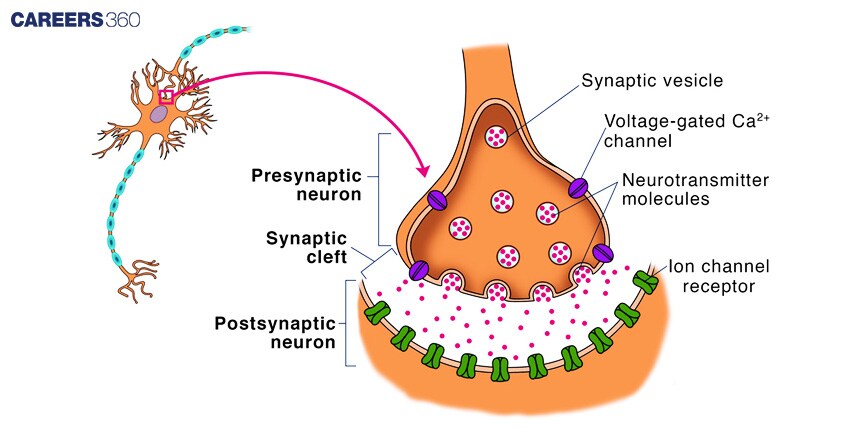Synapse: Definition, Meaning, Anatomy, Function, Types, Diagram
Definition Of Synapse
A synapse is a small junction located at the end of a neuron, communicating and connecting with another neuron. The neuron is set into action in propagating electrical or chemical signals that lead it to release neurotransmitters into the synapse; these released messengers in turn excite the receptors inside the receiving neuron.
Synapses form the core centre for the processing and transmission of information in the nervous system and thereby are a driving force for enabling complex functions corresponding to movement, perception, and thought processes.
Structure Of A Synapse
The synapse includes several components involved in the same, to pass the signals between the neurons.
Pre-synaptic Neuron:
Contains the synaptic vesicles full of neurotransmitters.
Synaptic Vesicles and Neurotransmitters: Dumps the neurotransmitters into the synaptic cleft.
Synaptic Cleft:
The minute gap or junction between neurons where neurotransmitters are dumped.
Post-synaptic Neuron:
Receptors and Signal Reception: Contains the receptors which are attached to the neurotransmitters leading to the propagation of response in the neuron.
Diagram: Structure Of Synapse

Types Of Synapses
Depending on the mode of transmission of the signal, synapses may be either chemical or electrical.
Chemical Synapses
Neurotransmitters released into the synaptic cleft convey the signal.
Examples and Importance: More commonly found in the central nervous system. The principle behind complex signalling processes.
Electrical Synapses
Ions are transmitted directly from the presynaptic to the postsynaptic neuron through gap junctions.
Examples and Significance: Present in some neural circuits; enable fast transmission of signals.
Synaptic Transmission
The synaptic transmission is a process by which a signal is being forwarded from one neuron to another.
Arrival of Action Potential: This subsequently leads to the stimulation of the extrusion of neurotransmitters.
Neurotransmitter release: neurotransmitters are released into the synaptic cleft by synaptic vesicles.
Neurotransmitter Binding: Transmitters are chemicals that bind to a certain receptor in the post-syn.
Generation of Post-synaptic Potential: The post-synaptic neuron generates a response in it.
Neurotransmitters
Neurotransmitters are chemicals that diffuse an impulse conduction at the synapse.
Act as a communicator between the neurons.
Types Of Neurotransmitters:
Excitatory Neurotransmitters (ex. Glutamate): Generates action potentials.
Inhibitory Neurotransmitters (e.g. GABA): Inhibit the action potentials
Modulatory Neurotransmitters (e.g. Dopamine, Serotonin): Modulate multiple neural processes.
Synapse Dysfunction And Associated Disorders
Disorders in synapse dysfunction are associated with both neurological and psychiatric illnesses.
Neurological Disorders:
- Alzheimer's Disease: Pathological in synaptic loss and dysfunction.
Parkinson's disease: Entails deficient synaptic transmission in motor pathways.
Psychiatric disorders:
Depression: Correlated with imbalances in neurotransmitter concentrations.
Schizophrenia: Correlated with defective synaptic connectivity and mechanisms.
Synapse Studies
There are various methods used in the studies that explore the status of synapses.
Microscopic Techniques:
Electron Microscopy provides very detailed images of the structures of synapses.
Live imaging can be done of the synapses through confocal microscopy.
Electrophysiological Techniques:
Through the Patch Clamp Technique recording of ion channel activities of neurons
Recommended Video On ‘Synapse’
Frequently Asked Questions (FAQs)
Synapses are both chemical in which the synapse has a neurotransmitter or electrical, in which case the synapse involves a direct ion flow through gap-like junctions, and both types allow the transmission of signals between the neurons.
Neurotransmitters are small molecules that bind to receptors on the post-synaptic neuron and may produce an excitatory or inhibitory response; thus, they influence the excitability of a neuron.
Synaptic plasticity can be defined as the ability of synaptic connections to strengthen, with the possibility of being weakened with time, critically involved in learning, memory, and adaptation.
By interfering with normal neural communication and signalling, synaptic dysfunction can cause such abnormalities as Alzheimer's, Parkinson's, depression, and schizophrenia.
A synapse is the junction between two neurons, in which electrical or chemical impulses are passed through, allowing communication to take place in the nervous system.